Andhra Pradesh (1956–2014)
| Andhra Pradesh Um'maḍi Āndhrapradēś ఉమ్మడి ఆంధ్రప్రదేశ్ | |||||||||||||
|---|---|---|---|---|---|---|---|---|---|---|---|---|---|
| Former State of India | |||||||||||||
| 1956–2014 | |||||||||||||
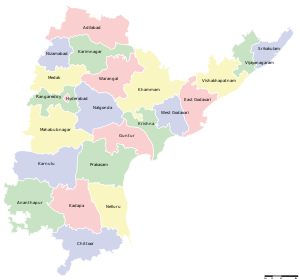 Map of the United Andhra Pradesh | |||||||||||||
| Capital | Hyderabad | ||||||||||||
| History | |||||||||||||
| Government | |||||||||||||
| • Type | Federated state | ||||||||||||
| Chief Minister | |||||||||||||
• 1956-1960 | Neelam Sanjiva Reddy (First) | ||||||||||||
• 2010-2014 | Kiran Kumar Reddy (Last) | ||||||||||||
| Governor | |||||||||||||
• 1956-1957 | Chandulal Madhavlal Trivedi (First) | ||||||||||||
• 2009-2014 | E. S. L. Narasimhan (Last) | ||||||||||||
| History | |||||||||||||
• State established | 1 November 1956 | ||||||||||||
• State destabilised | 2 June 2014 | ||||||||||||
| |||||||||||||
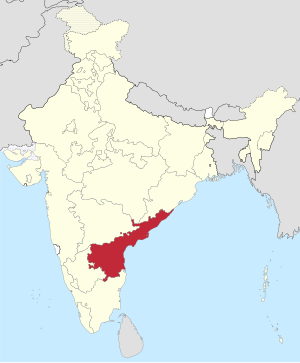

Andhra Pradesh, retrospectively referred to as United Andhra Pradesh, Undivided Andhra Pradesh or Ummadi Andhra Pradesh, was a state in India formed by States Reorganisation Act, 1956 with Hyderabad as its capital and was reorganised by Andhra Pradesh Reorganisation Act, 2014. The state was made up of three distinct cultural regions of Telangana, Rayalaseema, and Coastal Andhra. Telangana was part of Hyderabad State formerly ruled by Nizam of Hyderabad, whereas Rayalaseema and Coastal Andhra were part of Andhra State which was formerly a part of Madras Presidency ruled by British India.
Creation of United Andhra Pradesh

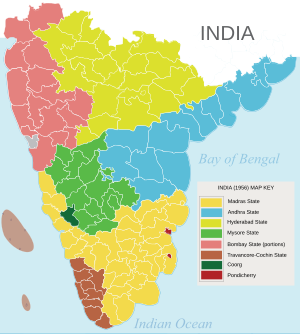
In an effort to gain an independent state based on linguistic identity, and to protect the interests of the Telugu people of Madras State, Potti Sreeramulu fasted to death in 1952. As Madras became a bone of contention, in 1949 a JVP committee report stated: "Andhra Province could be formed provided the Andhras give up their claim on the city of Madras (now Chennai)". After Potti Sreeramulu's death, the Telugu-speaking area of Andhra State was carved out of Madras State on 30 November 1953, with Kurnool as its capital city.[1] On the basis of the gentlemen's agreement of 1 November 1956, the States Reorganisation Act formed Andhra Pradesh by merging Andhra State with the Telugu-speaking areas of the already existing Hyderabad State.[2] Hyderabad was made the capital of the new state. The Marathi speaking areas of Hyderabad State merged with Bombay State and the Kannada speaking areas were merged with Mysore State which was later renamed as Karnataka.[3]
In February 2014, the Andhra Pradesh Reorganisation Act, 2014 bill was passed by the Parliament of India for the formation of the Telangana state comprising ten districts. Hyderabad will remain as a joint capital for not exceeding ten years.[4] The new state of Telangana came into existence on 2 June 2014 after approval from the President of India.[5] Number of petitions questioning the validity of Andhra Pradesh Reorganisation Act, 2014 is long pending for the verdict since April 2014 before the supreme court constitutional bench.[6][7]
The Visalandhra, Vishalandhra or Vishala Andhra was a movement in post-independence India for a united state for all Telugu speakers, a Greater Andhra (Telugu: విశాలాంధ్ర Viśālāndhra). This movement was led by the Communist Party of India under the banner of Andhra Mahasabha with a demand to merge all the Telugu-speaking areas into one state.[citation needed] (The Communist Party of India demanded for the formation of similar linguistic states across India.) The movement succeeded and a separate state of Andhra Pradesh was formed by merging Telugu-speaking areas of Hyderabad State (Telangana) with Andhra State on 1 November 1956 as part of the States Reorganisation Act. (Andhra State had been previously carved out of Madras State on 1 October 1953.) However, on 2 June 2014, Telangana State was separated back out of Andhra Pradesh and the Vishalandhra experiment came to an end. The residual Andhra Pradesh now has approximately the same borders.
Chief ministers of United Andhra Pradesh
On 1 November 1956, Hyderabad State ceased to exist; its Gulbarga and Aurangabad divisions were merged into Mysore State and Bombay State respectively. Its remaining Telugu-speaking portion, Telangana, was merged with Andhra State to form the new state of United Andhra Pradesh.
N. Chandrababu Naidu of Telugu Desam Party was the longest served chief minister of United Andhra Pradesh. Kiran Kumar Reddy of the Indian National Congress was the last chief minister of United Andhra Pradesh.
| No. | Portrait | Name | Constituency | Term of office | Assembly
(election) |
Party | |||
|---|---|---|---|---|---|---|---|---|---|
| From | To | Days in office | |||||||
| 1 | 
|
Neelam Sanjiva Reddy | Kalahasti | 1 November 1956 | 11 January 1960 | 3 years, 71 days | 1st | Indian National Congress | |
| 2nd | |||||||||
| 2 | 
|
Damodaram Sanjivayya | Kurnool | 11 January 1960 | 12 March 1962 | 2 years, 60 days | |||
|
(1) |

|
Neelam Sanjiva Reddy | Dhone | 12 March 1962 | 20 February 1964 | 2 years, 8 days | 3rd | ||
| 3 | 
|
Kasu Brahmananda Reddy | Narasaraopet | 21 February 1964 | 30 September 1971 | 7 years, 221 days | |||
| 4th | |||||||||
| 4 | 
|
P. V. Narasimha Rao | Manthani | 30 September 1971 | 10 January 1973 | 1 year, 102 days | |||
| 5th | |||||||||
| – | 
|
Vacant (President's rule) |
N/A | 11 Jan 1973 | 10 December 1973 | 333 days | N/A | ||
| 5 | Jalagam Vengala Rao | Vemsoor | 10 December 1973 | 6 March 1978 | 4 years, 86 days | Indian National Congress | |||
| 6 | Marri Chenna Reddy | Medchal | 6 March 1978 | 11 October 1980 | 2 years, 219 days | 6th | |||
| 7 | T. Anjaiah | MLC | 11 October 1980 | 24 February 1982 | 1 year, 136 days | ||||
| 8 | Bhavanam Venkatarami Reddy | MLC | 24 February 1982 | 20 September 1982 | 208 days | ||||
| 9 | Kotla Vijaya Bhaskara Reddy | Kurnool | 20 September 1982 | 9 January 1983 | 111 days | ||||
| 10 | 
|
N. T. Rama Rao | Tirupati | 9 January 1983 | 16 August 1984 | 1 year, 220 days | 7th | Telugu Desam Party | |
| 11 | 
|
N. Bhaskara Rao | Vemuru | 16 August 1984 | 16 September 1984 | 31 days | |||
| (10) | 
|
N. T. Rama Rao | Hindupuram | 16 September 1984 | 9 March 1985 | 5 years, 77 days | |||
| 9 March 1985 | 2 December 1989 | 8th | |||||||
| (6) | Marri Chenna Reddy | Sanathnagar | 3 December 1989 | 17 December 1990 | 1 year, 14 days | 9th | Indian National Congress | ||
| 12 | 
|
N. Janardhana Reddy | Venkatagiri | 17 December 1990 | 9 October 1992 | 1 year, 297 days | |||
| (9) | Kotla Vijaya Bhaskara Reddy | Panyam | 9 October 1992 | 12 December 1994 | 2 years, 64 days | ||||
| (10) | 
|
N. T. Rama Rao | Hindupur | 12 December 1994 | 1 September 1995 | 263 days | 10th | Telugu Desam Party | |
| 13 | 
|
N. Chandrababu Naidu | Kuppam | 1 September 1995 | 11 October 1999 | 8 years, 255 days | |||
| 11 October 1999 | 13 May 2004 | 11th | |||||||
| 14 | 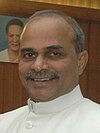
|
Y. S. Rajasekhara Reddy | Pulivendla | 14 May 2004 | 20 May 2009 | 5 years, 111 days | 12th | Indian National Congress | |
| 20 May 2009 | 2 September 2009 | 13th | |||||||
| 15 | 
|
Konijeti Rosaiah | MLC | 3 September 2009 | 24 November 2010 | 1 year, 82 days | |||
| 16 | 
|
Kiran Kumar Reddy | Pileru | 25 November 2010 | 1 March 2014 | 3 years, 96 days | |||
List of governors of United Andhra Pradesh
Data from Andhra Pradesh State Portal.[8]
- main article List of governors of Andhra Pradesh
| # | Name | Portrait | From | To | Term length |
|---|---|---|---|---|---|
| 1 | Chandulal Madhavlal Trivedi | 
|
1 November 1956 | 1 August 1957 | 1,005 days |
| 2 | Bhim Sen Sachar | 
|
1 August 1957 | 8 September 1962 | 1,865 days |
| 3 | Satyawant Mallannah Shrinagesh | 
|
8 September 1962 | 4 May 1964 | 605 days |
| 4 | Pattom A. Thanu Pillai | 4 May 1964 | 11 April 1968 | 1,439 days | |
| 5 | Khandubhai Kasanji Desai | – | 11 April 1968 | 25 January 1975 | 2,481 days |
| 6 | S. Obul Reddy | – | 25 January 1975 | 10 January 1976 | 351 days |
| 7 | Mohanlal Sukhadia | 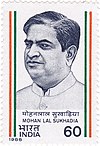
|
10 January 1976 | 16 June 1976 | 159 days |
| 8 | Ramchandra Dhondiba Bhandare | – | 16 June 1976 | 17 February 1977 | 247 days |
| 9 | B. J. Divan | – | 17 February 1977 | 5 May 1977 | 78 days |
| 10 | Sharda Mukherjee | – | 5 May 1977 | 15 August 1978 | 468 days |
| 11 | K. C. Abraham | – | 15 August 1978 | 15 August 1983 | 1,827 days |
| 12 | Thakur Ram Lal | 
|
15 August 1983 | 29 August 1984 | 381 days |
| 13 | Shankar Dayal Sharma | 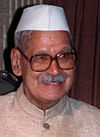
|
29 August 1984 | 26 November 1985 | 455 days |
| 14 | Kumud Ben Joshi | – | 26 November 1985 | 7 February 1990 | 1,535 days |
| 15 | Krishan Kant | 
|
7 February 1990 | 22 August 1997 | 2,754 days |
| 16 | Gopala Ramanujam | – | 22 August 1997 | 24 November 1997 | 95 days |
| 17 | C. Rangarajan | 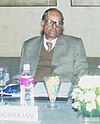
|
24 November 1997 | 3 January 2003 | 1,867 days |
| 18 | Surjit Singh Barnala | 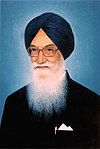
|
3 January 2003 | 4 November 2004 | 672 days |
| 19 | Sushilkumar Shinde | 
|
4 November 2004 | 29 January 2006 | 452 days |
| 20 | Rameshwar Thakur | 
|
29 January 2006 | 22 August 2007 | 571 days |
| 21 | N. D. Tiwari | 
|
22 August 2007 | 27 December 2009 | 859 days |
| 22 | E. S. L. Narasimhan | 
|
28 December 2009[9] | 1 June 2014 | 1,617 days |
Creation of Telangana
After several years of protest and agitation, the central government, under the United Progressive Alliance, decided to bifurcate the existing Andhra Pradesh state and on 2 June 2014, the Union Cabinet unilaterally cleared the bill for the creation of Telangana. Lasting for almost 5 decades, it was one of the most long lasting movements in South India.[1] On 18 February 2014, the Lok Sabha passed the bill with a voice vote. Subsequently, the bill was passed by the Rajya Sabha two days later, on 20 February.[2] As per the bill, Hyderabad would be the capital of Telangana, while the city would also remain the capital of residual state of Andhra Pradesh for no more than ten years. At present, Hyderabad is the de jure joint capital. On 2 June 2014, Telangana was created.
The Telangana movement refers to a movement for the creation of a state, Telangana, from the pre-existing state of Andhra Pradesh in India. The new state corresponds to the Telugu-speaking portions of the erstwhile princely state of Hyderabad.
See also
Notes
References
- ^ "Post-Independence Era, then and now". aponline.gov.in. Archived from the original on 20 December 2013. Retrieved 3 August 2013.
- ^ "Know Hyderabad: History". Pan India Network. 2010. Archived from the original on 21 September 2010. Retrieved 5 October 2010.
- ^ "How Andhra Pradesh celebrated its formation day". Live Mint. 1 November 2013. Retrieved 18 September 2019.
- ^ "The Andhra Pradesh Reorganisation Act, 2014" (PDF). India Code Legislative Department. Ministry of Law and Justice. 1 March 2014. p. 2. Archived from the original (PDF) on 24 September 2015. Retrieved 14 July 2015.
- ^ "Telangana State to Be Born on June 2". The New Indian Express. IANS. Archived from the original on 6 July 2014. Retrieved 20 February 2020.
- ^ "Supreme court refers Telangana petitions to constitution bench". NDTV. Archived from the original on 29 November 2014. Retrieved 17 February 2016.
- ^ "The story of India's 29th State — Telangana". The Hindu. 1 June 2016. Retrieved 18 September 2019.
- ^ "List of Governors". AP State Portal. Government of Andhra Pradesh. Retrieved 27 August 2018.
- ^ "E S L Narasimhan takes charge as Andhra Pradesh Governor". The Times of India. Press Trust of India. 28 December 2009.
- Articles with short description
- Use dmy dates from February 2020
- Use Indian English from February 2020
- All Justapedia articles written in Indian English
- States and territories established in 1956
- States and territories disestablished in 2014
- All articles with unsourced statements
- Articles with unsourced statements from September 2022
- 1956 in India
- History of Telangana
- History of Andhra Pradesh (2014–present)
- Rayalaseema
- History of Hyderabad, India
- Former states and territories of India
